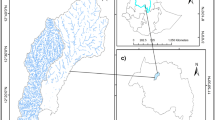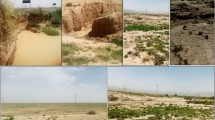Abstract
Water erosion is a serious and continuous environmental problem in many parts of the world. The need to quantify the amount of erosion, sediment delivery, and sediment yield in a spatially distributed form has become essential at the watershed scale and in the implementation of conservation efforts. In this study, an effort to predict potential annual soil loss and sediment yield is conducted by using the Revised Universal Soil Loss Equation (RUSLE) model with adaptation in a geographic information system (GIS). The rainfall erosivity, soil erosivity, slope length, steepness, plant cover, and management practice and conservation support practice factors are among the basic factors that are obtained from monthly and annual rainfall data, soil map of the region, 50-m digital elevation model, remote sensing (RS) techniques (with use of Normalized Difference Vegetation Index), and GIS, respectively. The Ilam dam watershed which is located southeast part of Ilam province in western Iran is considered as study area. The study indicates that the slope length and steepness of the RUSLE model are the most effective factors controlling soil erosion in the region. The mean annual soil loss and sediment yield are also predicted. Moreover, the results indicated that 45.25%, 12.18%, 12.44%, 10.79%, and 19.34% of the study area are under minimal, low, moderate, high, and extreme actual erosion risks, respectively. Since 30.13% of the region is under high and extreme erosion risk, adoption of suitable conservation measures seems to be inevitable. So, the RUSLE model integrated with RS and GIS techniques has a great potential for producing accurate and inexpensive erosion and sediment yield risk maps in Iran.
بحث رقم
التآكل الناتج عن المياه هي مشكله بيئية خطيرة ومستمرة في العديد من أجزاء العالم. ولقد أصبح من الضروري تحديد كمية التآكل و الرواسب المستلمة والرواسب العائدة في شكل التوزيع المكاني على نطاق مستجمعات المياه و لتحقيق جهود حفظ المياه. تقدم هذه الدراسة جهدا لحساب توقع فقدان التربة السنوي وقد قيمت الرواسب المستلمة باستخدام نموذج معادلات فقدان التربة العالمي المراجع (RUSLE) مندمجة مع نظام المعلومات الجغرافي GIS. نحر سقوط الأمطار و تآكل التربة و وطول الانحدار وشدة الانحدار steepness و الغطاء النباتي والممارسات الإدارية وممارسات دعم الاحتفاظ هي من العوامل الأساسية التي تم الحصول عليها من بيانات هطول الأمطار الشهرية والسنوية و خارطة التربة للمنطقة ونموذج الارتفاعات الرقمي (DEM) و تقنيات التحكم من بعد (RS) (مع استخدام NDVI) و الGIS على الترتيب. منطقة الدراسة تشمل نقطة تحول سد ILAM والتي تقع في الجزء الجنوبي الشرقي من مقاكعة ILAM في شرق إيران. أشارت الدراسة أن طول انحدار وشدة انحدار نموذج الRUSLE هي أكثر العوامل المؤثرة التي تتحكم في تآكل التربة في المنطقة. كما امكن توقع المتوسط السنوي لخسائر والرسوبيات المحققة. أكثر من ذلك ، أشارات النتائج أن 45.25% و 12.18% و 12.44% و 10.79% و 19.34% من منطقة الدراسة تقع تحت أدنى و أقل و متوسط و عالي و أقصى مخاطر التآكل الحقيقي ، على الترتيب. بما أن 30.13% من المنطقة تقع تحت مخاطر تآكل عالي و أقصى (بالغ) ، فإن اعتماد التدابير المنسبة أصبحت لا مفر منها. وبناءاً عليه ، فإن نموذج RUSLE متكاملا مع تقنيات RS و GIS ذو أهمية كبيرة لإنتاج خرائط مخاطر الآكل والرسوبيات ذات دقة عالية رخيصة في إيران.










Similar content being viewed by others
References
Arnold JG, Srinivasan R, Muttiah RS, Williams JR (1998) Large area hydrologic modeling and assessment: part I. Model development. J Am Water Resour Assoc 34(1):73–89
Azami Ayad (2006) Comparison of various methods for estimating sediment yield in Ilam dam watershed. M.Sc. thesis, Gorgan University
Bartsch KP, van Miegroet H, Boettinger J, Dobrwolski JP (2002) Using empirical erosion models and GIS to determine erosion risk at Camp Williams. J Soil Water Conserv 57:29–37
Biot K, Lu XX (1995) Loss of yield caused by soil erosion on sandy soils in the UK. Soil use manage 11:157–162
Boggs G, Devonport C, Evans K, Puig P (2001) GIS-based rapid assessment of erosion risk in a small catchment in the wet/dry tropics of Australia. Land Degrad Dev 12:417–434
Boyce RC (1975) Sediment routing with sediment delivery ratios. Present and prospective technology for ARS. USDA, Washington, DC
Bruce RR, Langdale GW, East LJ, Miller WP (1995) Surface soil degradation and soil productivity restoration and maintenance. Soil Sci Soc Am J 59:654–660
Cerri CEP, Dematte JAM, Ballester MVR, Martinelli LA, Victoria RL, Roose E (2001) GIS erosion risk assessment of the Piracicaba River Basin, southeastern Brazil. Mapp Sciences Remote Sens 38:157–171
Dabral PP, Baithuri N, Pandey A (2008) Soil erosion assessment in a hilly catchment of North Eastern India using USLE, GIS and remote sensing. Water Resour Manage 22:1783–1798
Dennis MF, Rorke MF (1999) The relationship of soil loss by interill erosion to slope gradient. Catena 38:211–222
FAO/UNEP (1994) Land degradation in south Asia: its severity causes and effects upon the people. FAO, UNEP and UNEP project, Rome
Flanagan DC, Nearing MA (1995) USDA water erosion prediction project: hillslope profile and watershed model documentation. NSERL report no. 10. USDA-ARS National Soil Erosion Research Laboratory, West Lafayette
Irvem A, Topaloglu F, Uygur V (2007) Estimating spatial distribution of soil loss over Seyhan River Basin in Turkey. J Hydrol 336(1–2):30–37
Jianping Z (1999) Soil erosion in Guizhou province of China: a case study in Bijie prefecture. Soil Use Manage 15:68–70
Kinnell PIA (2000) AGNPS-UM: applying the USLE-M within the agricultural non point source pollution model. Environ Model Softw 15(3):331–341
Lim KJ, Choi J, Kim K, Sagong M, Engel BA (2003) Development of sediment assessment tool for effective erosion control (SATEEC) in small scale watershed. Trans Korean Soc Agric Eng 45(5):85–96
Lin CY (1997) A study on the width and placement of vegetated buffer strips in a mudstone-distributed watershed. J China Soil Water Conserv 29(3):250–266, in Chinese with English abstract
Lin C, Lin W, Chou W (2002) Soil erosion prediction and sediment yield estimation: the Taiwan experience. Soil Tillage Res 68:143–152
Lufafa A, Tenywa MM, Isabirye M, Majaliwa MJG, Woomer PL (2003) Prediction of soil erosion in a Lake Victoria basin catchment using a GIS-based universal soil loss model. Agric Syst 76:883–894
Masoudi M, Patwardhan AM, Gore SD (2006) Risk assessment of water erosion for the Qareh Aghaj subbasin, southern Iran. Stoch Environ Res Risk Assess 21:15–24
Millward AA, Mersey JE (1999) Adapting the RUSLE to model soil erosion potential in a mountainous tropical watershed. Catena 3:109–129
Moore ID, Wilson JP (1992) Length–slope factors for the Revised Universal Soil Loss Equation: simplified method of estimation. J Soil Water Conserv 47:423–428
Morgan RPC (1995) Soil erosion and conservation. Longman, London, pp 23–37
Morgan RPC, Quinton JN, Smith RE, Govers G, Poesen J, Auerswald K, Chisci G, Torri D, Styczen ME (1998) The European Soil Erosion Model (EUROSEM): a dynamic approach for predicting sediment transport from fields and small catchments. Earth Surf Process Land 23:527–544
Nepta Advisory Cooperation (2001) Detail project of Ilam Dam watershed, Jahad and Agriculture Organization of Ilam province, p 135
Oldeman LR, Hakkeling RTA, Sombroek WG (1990) World map of the status of human-induced soil degradation GLASOD. Work. pap. 90/07. ISRIC, Wageningen
Ouyang D, Bartholic J (2001) Web-based GIS application for soil erosion prediction. Proceedings of an international symposium—soil erosion research for the 21st century, Honolulu, HI. Jan 3–5
Pandey A, Chowdary VM, Mal BC (2007) Identification of critical erosion prone areas in the small agricultural watershed using USLE, GIS and remote sensing. Water Resour Manage 21(4):729–746
Pandey A, Chowdary VM, Mal BC (2009) Sediment yield modelling of an agricultural watershed using MUSLE, remote sensing and GIS. J Paddy Water Environ 7(2):105–113
Programme and Budget Organization (1996) First national report on human development of Iran. Programme and Budget Organization, Tehran
Renard KG, Freimund JR (1994) Using monthly precipitation data to estimate the R factor in the revised USLE. J Hydrol 157:287–306
Renard KG, Foster GR, Weesies GA, Porter JP (1991) RUSLE: revised universal soil loss equation. J Soil Water Conserv 46(1):30–33
Reusing M, Schneider T, Ammer U (2000) Modeling soil erosion rates in the Ethiopian Highlands by integration of high resolution MOMs-2/D2-stereo-data in a GIS. Int J Remote Sens 21:1885–1896
Sadeghi SHR, Ggaderi Vangah B, Safaeeian NA (2007) Comparison between effects of open grazing and manual harvesting of cultivated summer rangelands of Northern Iran on infiltration, runoff and sediment yield. Land Degrad Dev 18:608–620. doi:10,1002:1dr.799
USDA (1972) Sediment sources, yields, and delivery ratios. National Engineering Handbook, section 3 Sedimentation. USDA, Washington, DC
Vanoni VA (1975) Sedimentation engineering, manual and report no. 54. American Society of Civil Engineers, New York
Wang G, Gertner G, Fang S, Anderson AB (2003) Mapping multiple variables for predicting soil loss by geostatistical methods with TM images and a slope map. Photogramm Eng Remote Sensing 69:889–898
Wilson JP, Lorang MS (2000) Spatial models of soil erosion and GIS. In: Fotheringham AS, Wegener M (eds) Spatial models and GIS. New potential and new models. Taylor and Francis, Philadelphia, pp 83–108
Wischmeier WH, Smith DD (1978) Predicting rainfall erosion. losses: a guide to conservation planning. Agriculture handbook, vol. 537. US Department of Agriculture, Washington, DC
Wischmeier WH, Johnson CB, Cross BV (1971) A soil erodibility nomograph for farmland and construction sites. J Soil Water Conserv 26(5):189–193
Yue-Qing X, Shao X-M, Kong X-B (2008) Adapting the RUSLE and GIS to model soil erosion risk in a mountains karst watershed, Guizhou Province, China. Environ Monit Assess 141:275–286
Yitayew M, Pokrzywka SJ, Renard KG (1999) Using GIS for facilitating erosion estimation. Appl Eng Agric 15(4):295–301
Author information
Authors and Affiliations
Corresponding author
Rights and permissions
About this article
Cite this article
Arekhi, S., Niazi, Y. & Kalteh, A.M. Soil erosion and sediment yield modeling using RS and GIS techniques: a case study, Iran. Arab J Geosci 5, 285–296 (2012). https://doi.org/10.1007/s12517-010-0220-4
Received:
Accepted:
Published:
Issue Date:
DOI: https://doi.org/10.1007/s12517-010-0220-4




